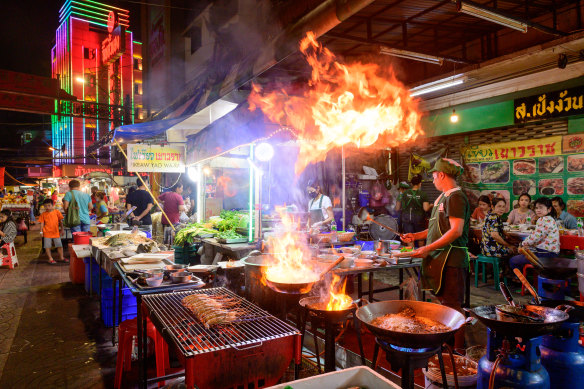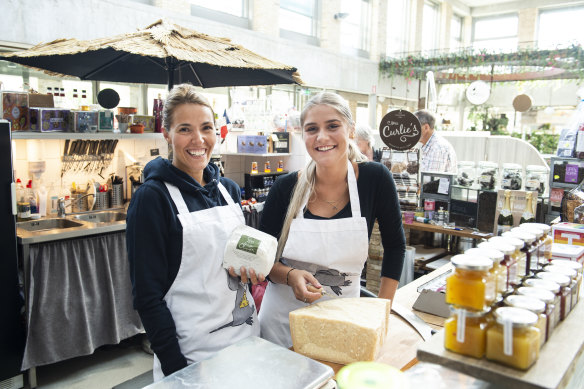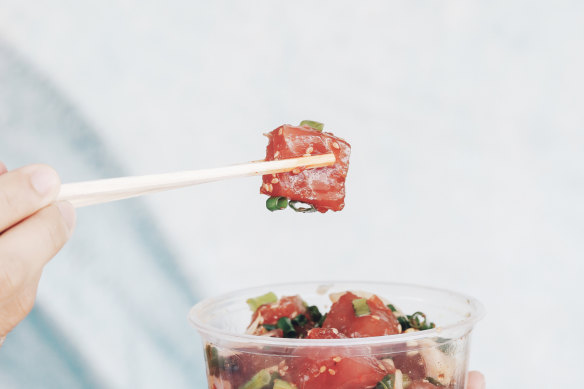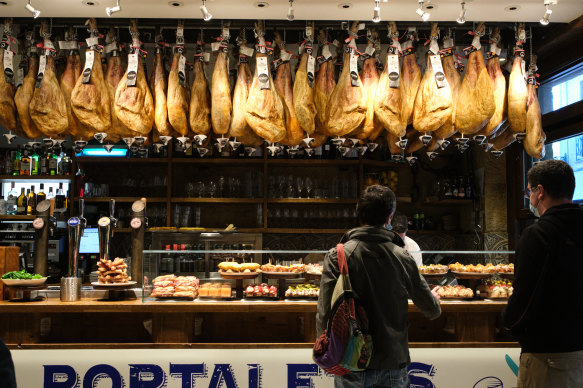This was published 1 year ago
Who needs restaurants? The world’s 10 best places for cheap eats
Ask any foodie professional, top chefs included, and they will confirm that good food doesn’t begin and end at restaurants.
Yes, even those responsible for helming professional kitchens understand that there is a whole world of cuisine out there that doesn’t adhere to the traditional restaurant model.
Have you ever stood outside a Spanish bar, feasting on bite-sized tapas? Have you wandered a Singaporean hawker centre, struck with voracious indecision? Have you eaten at a Thai street food market, engulfed by a heady, spicy, smoky aroma?
If you want high-quality, authentic local food when you travel, there is absolutely no need to limit yourself to the restaurant experience, and with the cost of living hitting hard Down Under, you’ll appreciate the dollars saved.

A chef cooks at a street side restaurant in Bangkok.Credit: iStock
Markets, food halls, food trucks, home cooks … these alternatives are not just good for your stomach, but good for your wallet too, as they offer a far more budget-friendly, and arguably more authentic, experience than sitting down with waiter service for a full, sometimes formal and extended meal.
Of course, we still love dining at a restaurant. However, if you’re keen to sample great, affordable food when you travel, and you hunger for interesting experiences to match the fare, these are some alternatives you really should seek out.
Depachika, Japan
The lowdown It’s time to go deep. We’re talking deep underground, to the lower basement levels under major department stores, where you will find an absolute wonderland of gourmet ingredients and pre-packed food items at a Japanese depachika. These food halls are phenomenal for their pure scale, and, of course, the quality of the produce. You won’t find depachika everywhere, though if you’re in a major city, head to any large department store and there’s a good chance at least one or two of the basement levels will be devoted entirely to food (with restaurants on the upper levels). We’re talking bento boxes, pastries, chocolates and other ready-to-eat items, as well as fresh produce such as wagyu beef, and high-end fruits and vegetables for use if you have access to a kitchen.

The art of good food: Mitsukoshi Department Store, Ginza, Toyko,Credit: Alamy
Must try For travellers, bento boxes will make the most sense, and the range available in any depachika will be mind-boggling. Keep an eye out for other Japanese specialty items, too: from sake and local whisky, to perfect berries and melons, to “wagashi” sweets to pair with matcha tea.
More Find depachika underneath department stores such as Takashimaya, Mitsukoshi and Isetan in major Japanese cities. See japan.travel
Market halls, Scandinavia
The lowdown The rest of the world might only just be waking up to the greatness of Nordic cuisine, thanks to high-end restaurants such as Noma, Geranium, Frantzen and Maaemo – but there has always been amazing and more accessible food in Scandinavia. You just have to know where to find it. One of the best places is a “market hall”, a covered area that hosts not just purveyors of fresh produce, but also stalls selling sandwiches and meals to go, or even piping hot counter meals. You will find these halls in the major cities of Sweden, Denmark, Norway, Iceland and Finland, and they’re cherished and well-patronised communal spaces.

A market hall in Sweden.
Must try This depends on the market you choose. At Ostermalms Saluhall in Stockholm you’ll find an excellent cheese selection, while Feskekorka in Gothenburg is all about fish. Mathallen Oslo, meanwhile, has great baked goods and coffee. At any, however, you will have the choice to sit down and enjoy a meal, or take ingredients away.
More Market halls in Sweden and across Scandinavia tend to open during normal business hours, from morning until early evening. See visitsweden.com
Shawarma stands, Middle East
The lowdown We’ve said “Middle East” here, rather than a specific country because you will find shawarma stands in Lebanon, Palestine, Israel, Egypt, Iraq and beyond, and it seems a disservice to just call out one. The culture of shawarma, closely related to Greek gyros and Turkish doner, is roughly the same: spiced, marinated meat is grilled on a vertical rotisserie, then sliced and stuffed or rolled into bread with vegetables and yoghurt or a tahini-based sauce. This is not fancy food. It’s not typically served in sit-down restaurants. It’s the kind of thing prepared at hole-in-the-wall kitchens or mobile food carts, grab-and-go cuisine that’s enjoyed by locals and visitors from all walks of life.
Must try There are all sorts of variations to shawarma, some regional, some cultural, some just a matter of taste. In some places the meat will be lamb, some chicken, some turkey. The bread will be pita, or laffa, or flatbread. The filling will sometimes include pickles, sometimes not. But you can’t go wrong.
More Find shawarma shops and stands wherever you go in much of the Middle East – most tend to open for lunch and dinner.
Makgeolli bars, South Korea
The lowdown Makgeolli is a milky, lightly sparkling alcoholic brew, similar to soju or Japanese sake, usually unpasteurised, with a noticeable sweetness and funk. A makgeolli bar, meanwhile, is a small establishment that specialises in the sale of makgeolli, which is always paired with food. Herein lies the greatness of the makgeolli bar. Yes, the beverage is tasty and the atmosphere is always casual and friendly. But the food, which can seem like something of an afterthought, is incredibly good, and affordable. Who needs a restaurant when you can eat this well and drink to your heart’s content in a rowdy bar?
Must try Plenty of makgeolli bars will have a set menu of food offerings, and bring out increasingly complex dishes the more rounds of drinks you buy. These dishes will start off as classics such as savoury pancakes with kimchi or chives, before moving on to crispy fried seafood, grilled meats with bulgogi or spicy gochujang, to rare delicacies that will challenge your perception of bar food forever.
More The cities of Seoul and Busan are best for makgeolli bars, though you will find them throughout the country, open late into the night. See visitkorea.or.kr
Puertas Cerradas, Argentina
The lowdown The words “puerta cerrada” mean “closed door”, which gives you an idea of the atmosphere of these eateries – they’re not restaurants, but rather private institutions, often located in the home of the chef or owner, offering intimate experiences for those lucky enough to score a booking. Good food, good wine, and plenty of conversation: that’s what you’re in for. There was a boom in puertas cerradas in Buenos Aires about a decade ago, as chefs tried to find an alternative to the traditional restaurant model; though numbers of these eateries are dwindling, there are still a few classics that offer a unique dining experience.
Must try Probably the best-known puerta cerrada is Casa Saltshaker (casasaltshaker.com), run by American expat Dan Perlman and his partner Henry Tapia. The pair have an apartment in Recoleta, where they serve pan-European dishes with matching wines around a communal table. Also recommended, Casa Coupage (casacoupage.com) is a larger outfit doing fine-dining cuisine with excellent wine.
More Buenos Aires’ puertas cerradas tend to only open for dinner, and as this is Argentina, that dinner will begin about 9pm. Bookings essential. See argentina.travel
Food trucks, US
The lowdown There is no need to go to a restaurant if you want to eat well in the US. There’s no need to worry about the tipping nightmare. There’s no need to pay exorbitant prices. All you need to do is look for a small truck or caravan parked by the side of the road, with a few signs out, and you’re in your happy place. Food truck culture has boomed in the US in the past decade. What began as basic, blue-collar cuisine has morphed into the gourmet realm, an avenue for creative young chefs to avoid all the overheads of traditional restaurants and take their food to the streets.

Hits the spot ... a food truck poke snack in Hawaii.
Must try The food truck credited with kicking off the boom is Kogi BBQ, which peddles “Korean tacos” on the streets of Los Angeles to this day. Still, in cities such as Portland, Austin, Denver, Philadelphia and New York you will find all manner of culturally authentic or wildly creative snacks and meals sold from trucks.
More The opening hours and locations of food trucks vary – research your individual destination and desires online. See visittheusa.com.au
Street food stands, Mexico
The lowdown It’s true: many countries have street food with some featured in this cover story. However, few have a culture to match that of Mexico, where some of the nation’s finest cuisine, complex dishes that have taken millennia to perfect, are served from open-air carts by the side of the road. You’ll find street-food stands everywhere in Mexico. Sometimes they will be gathered in semi-formal marketplaces, other times strewn haphazardly around the city streets. The food will be typical of that state or even city, but it will usually include tortillas, and grilled meat, and salsas pounded from chillies the likes of which you’ve never even seen before.
Must try Start with one of the most ubiquitous snacks: “elotes”, ears of corn that are char-grilled and served with mayonnaise, cheese, chilli and lime. Then you’re going to find tacos, mostly meat-based, though look out for “nopales”, or cactus-fruit tacos. And if you can, try “tortas” – Mexican sandwiches – tamales, flautas (deep-fried tacos), tlacoyos (blue-corn tortillas with crispy pork skin), and churros.
More Street food is available in Mexico every second of every day, though the dishes on offer will vary throughout. See visitmexico.com
Tapas bars, Spain
The lowdown Don’t feel like sitting down for a full three- or four-course dinner? Then how about standing up for a moveable feast? On the Iberian Peninsula, plenty of dining is done upright, out on the street, with a drink in one hand and a snack in the other. Welcome to tapas culture, where food is just part of an experience that’s as much about social engagement as gastronomic delight. A “tapa” is a small portion of food, sometimes as simple as a plate of Manchego cheese, or as complex as a three-Michelin-star meal in miniature. Regardless of the intricacy of the fare, the dining culture is the same: relaxed, friendly, with food orders yelled over a bar and drinks taken onto the street outside.

Jamones de Jabugo on the counter of a bar in San Sebastian, Basque Country, Spain. Credit: iStock
Must try This will depend upon where you’re doing your “ir de tapas”, or tapas crawl. In Andalucia, in Spain’s south, try jamon, smoked fish, and salmorejo, a cold tomato soup. In the north, sample anchovies, tuna, and anything made with cod or hake. And you will find tortilla espanola everywhere.
More Most tapas bars around Spain are open for lunch and dinner, and serve food well into the night. Some even open for breakfast. See spain.info
Street food markets, Thailand
The lowdown Heaven. That’s what it is. If you love to eat, then a street-food market in Thailand will be your personal nirvana. There is a deeply ingrained culture here of eating high-quality food from street vendors who have been plying their trade for decades, and charging little more than a few dollars for the privilege of sampling their cuisine. Street food vendors tend not to appear at random in Thailand, but rather gather at specific points, open-air marketplaces on the side of streets and sometimes across the streets themselves. The food is usually local to the region, cheap, and eaten at trestle tables nearby.
Must try In every region of Thailand you will find different specialties, though you can usually rely on finding the likes of pad Thai or other stir-fried noodles, som tam (green papaya salad), Thai omelettes, char-grilled sausages, and pad kra pao (stir-fried pork with holy basil). Portions are on the small side, which means you can fit a few dishes in.
More Though some Thai street food vendors operate during the day, peak period for this style of eating is at night. Ask around for local favourites. See amazingthailand.com.au
Hawker centres, Singapore
The lowdown Back in the 1950s, under new self-governance, Singaporeans decided to clean up their street food scene and install hawkers in permanent food centres, where locals would still be able to eat on the cheap, only in slightly more salubrious surrounds. Those hygienic hawker centres proved a huge success, and they still thrive today, with more than 100 spread across the city. The system of eating here is simple: you wander the market and check out the vendors, who tend to specialise in only one or two dishes, before making your selection, lining up and purchasing. Carry your food back to a table and tuck in, before returning your tray to a well-marked station.
Must try There are so, so many dishes to sample at a Singapore hawker centre. Classics such as Hainanese chicken rice, char kway teow and fish-ball noodle soup turn up everywhere; however, also keep an eye out for Indian murtabak, satays, mee goreng, pork noodles, curry puffs and more.
More Singaporean hawker centres open early and close late, though individual hawker opening hours vary wildly. See visitsingapore.com
If you really want a restaurant…
Bangkok, Thailand
Though its street-food offerings are famous, the Thai capital also boasts an abundance of high-quality, low-cost restaurants. These range from super-casual joints serving local fare, to Western-style eateries run by expats, to fine-dining restaurants that will still be accessible to most foreign visitors. See amazingthailand.com.au
Naples, Italy
Let’s start at the top. Gino Sorbillo is a well-known pizzeria in Naples, one of the city’s finest, and an entire pizza there will not cost you more than €10 (about $16). In most restaurants in Naples, it’s cheaper. A bowl of the heartiest, most delicious ragu Napoletana you’ve ever tasted, at Restaurant Tandem, will also set you back less than €10. See italia.it
Colombo, Sri Lanka
At Ministry of Crab - probably Colombo’s fanciest and most expensive restaurant - a one-kilogram mud crab cooked in a curry, black pepper or chilli sauce will set you back about $150. And that’s the absolute premium, the best in town. Generally, restaurant meals in the Sri Lankan capital are far cheaper, and just as good. See srilanka.travel
Buenos Aires, Argentina
The Argentine economy has been through some rough times, which have made costs fluctuate wildly. Even so, to eat a full meal at a mid-priced restaurant in Buenos Aires should only cost you $20 a person. To scale up to a premium steakhouse you could be looking at $50, which still represents excellent value. See argentina.travel
Ho Chi Minh City, Vietnam
Though the word “restaurant” tends to denote somewhere formal and fancy, that’s not the case in Ho Chi Minh City. Restaurants here are often very casual affairs, where there’s just one dish on offer: maybe pho, the noodle soup, or banh xeo, the savoury pancake, or bo la lot, beef wrapped in betel leaves. All are affordable, and delicious. See vietnam.travel
Sign up for the Traveller Deals newsletter
Get exclusive travel deals delivered straight to your inbox. Sign up now.